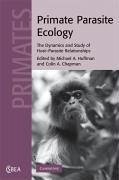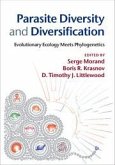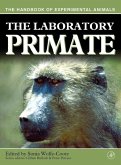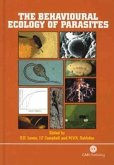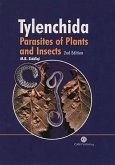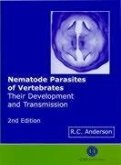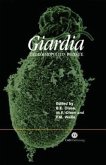Primate Parasite Ecology
The Dynamics and Study of Host-Parasite Relationships
Herausgeber: Huffman, Michael A; Chapman, Colin A
Primate Parasite Ecology
The Dynamics and Study of Host-Parasite Relationships
Herausgeber: Huffman, Michael A; Chapman, Colin A
- Gebundenes Buch
- Merkliste
- Auf die Merkliste
- Bewerten Bewerten
- Teilen
- Produkt teilen
- Produkterinnerung
- Produkterinnerung
Introduces methodology for studying host-parasite interactions, integrating laboratory methodology, field research, and theory.
Andere Kunden interessierten sich auch für
![Parasite Diversity and Diversification Parasite Diversity and Diversification]() Parasite Diversity and Diversification141,99 €
Parasite Diversity and Diversification141,99 €![The Laboratory Primate The Laboratory Primate]() Sonia Wolfe-Coote (Volume ed.)The Laboratory Primate332,99 €
Sonia Wolfe-Coote (Volume ed.)The Laboratory Primate332,99 €![The Behavioural Ecology of Parasites The Behavioural Ecology of Parasites]() Edwin E LewisThe Behavioural Ecology of Parasites320,99 €
Edwin E LewisThe Behavioural Ecology of Parasites320,99 €![The Spatial and Temporal Dynamics of Host-Parasitoid Interactions The Spatial and Temporal Dynamics of Host-Parasitoid Interactions]() Michael P HassellThe Spatial and Temporal Dynamics of Host-Parasitoid Interactions188,99 €
Michael P HassellThe Spatial and Temporal Dynamics of Host-Parasitoid Interactions188,99 €![Tylenchida Tylenchida]() CabiTylenchida551,99 €
CabiTylenchida551,99 €![Nematode Parasites of Vertebrates Nematode Parasites of Vertebrates]() CabiNematode Parasites of Vertebrates442,99 €
CabiNematode Parasites of Vertebrates442,99 €![Giardia Giardia]() Barbara E OlsonGiardia320,99 €
Barbara E OlsonGiardia320,99 €-
-
-
Introduces methodology for studying host-parasite interactions, integrating laboratory methodology, field research, and theory.
Hinweis: Dieser Artikel kann nur an eine deutsche Lieferadresse ausgeliefert werden.
Hinweis: Dieser Artikel kann nur an eine deutsche Lieferadresse ausgeliefert werden.
Produktdetails
- Produktdetails
- Verlag: Cambridge University Press
- Seitenzahl: 548
- Erscheinungstermin: 23. März 2009
- Englisch
- Abmessung: 229mm x 152mm x 28mm
- Gewicht: 975g
- ISBN-13: 9780521872461
- ISBN-10: 0521872464
- Artikelnr.: 26203518
- Herstellerkennzeichnung
- Produktsicherheitsverantwortliche/r
- Europaallee 1
- 36244 Bad Hersfeld
- gpsr@libri.de
- Verlag: Cambridge University Press
- Seitenzahl: 548
- Erscheinungstermin: 23. März 2009
- Englisch
- Abmessung: 229mm x 152mm x 28mm
- Gewicht: 975g
- ISBN-13: 9780521872461
- ISBN-10: 0521872464
- Artikelnr.: 26203518
- Herstellerkennzeichnung
- Produktsicherheitsverantwortliche/r
- Europaallee 1
- 36244 Bad Hersfeld
- gpsr@libri.de
Primate disease ecology: an integrative approach; Part I. Methods to Study
Primate-Parasite Interactions: 1. Collection methods and diagnostic
procedures for primate parasitology; 2. Methods of collection and
identification of minute nematodes from the feces of primates, with special
application to coevolutionary study of pinworms; 3. The utility of
molecular methods for elucidating primate-pathogen relationships - the
Oesophagostomum bifurcum example; 4. The application of endocrine measures
in primate parasite ecology; 5. Using agent-based models to investigate
primate disease ecology; Part II. The Natural History of Primate-Parasite
Interactions: 6. What does a parasite see when it looks at a chimpanzee?;
7. Primate malarias: evolution, adaptation, and species jumping; 8. Disease
avoidance and the evolution of primate social connectivity: Ebola, bats,
gorillas, and chimpanzees; 9. Primate-parasitic zoonoses and
anthropozoonses: a literature review; 10. Lice and other parasites as
markers of primate evolutionary history; 11. Cryptic species and
biodiversity of lice from primates; 12. Prevalence of Clostridium
perfringens in intestinal microflora of non-human primates; 13. Intestinal
bacteria of chimpanzees in the wild and in captivity - an application of
molecular ecological methodologies; 14. Gastrointestinal parasites of
bonobos in the Lomako Forest, Democratic Republic of Congo; 15. Habitat
disturbance and seasonal fluctuations of lemur parasites in the rain forest
of Ranomafana National Park, Madagascar; 16. Chimpanzee-parasite ecology at
Budongo Forest (Uganda) and the Mahale Mountains (Tanzania): influence of
climatic differences on self-medicative behavior; Part III. The Ecology of
Primate-Parasite Interactions: 17. Primate exposure and the emergence of
novel retroviruses; 18. Overview of parasites infecting howler monkeys,
Alouatta sp., and potential consequences of human-howler interactions; 19.
Primate parasite ecology: patterns and predictions from an ongoing study of
Japanese macaques; 20. Crop raiding: the influence of behavioral and
nutritional changes on primate-parasite relationships; 21. Can parasites
infections be a selective force influencing primate group size? A test with
red colobus; 22. How does diet quality affect the parasite ecology of
mountain gorillas?; 23 Host-parasite Dynamics: Connecting Primate Field
Data to Theory; Part IV. Conclusions: 24. Ways forward in the study of
primate disease ecology; 25. Useful diagnostic references and images of
protozoans, helminths, and nematodes commonly found in wild primates.
Primate-Parasite Interactions: 1. Collection methods and diagnostic
procedures for primate parasitology; 2. Methods of collection and
identification of minute nematodes from the feces of primates, with special
application to coevolutionary study of pinworms; 3. The utility of
molecular methods for elucidating primate-pathogen relationships - the
Oesophagostomum bifurcum example; 4. The application of endocrine measures
in primate parasite ecology; 5. Using agent-based models to investigate
primate disease ecology; Part II. The Natural History of Primate-Parasite
Interactions: 6. What does a parasite see when it looks at a chimpanzee?;
7. Primate malarias: evolution, adaptation, and species jumping; 8. Disease
avoidance and the evolution of primate social connectivity: Ebola, bats,
gorillas, and chimpanzees; 9. Primate-parasitic zoonoses and
anthropozoonses: a literature review; 10. Lice and other parasites as
markers of primate evolutionary history; 11. Cryptic species and
biodiversity of lice from primates; 12. Prevalence of Clostridium
perfringens in intestinal microflora of non-human primates; 13. Intestinal
bacteria of chimpanzees in the wild and in captivity - an application of
molecular ecological methodologies; 14. Gastrointestinal parasites of
bonobos in the Lomako Forest, Democratic Republic of Congo; 15. Habitat
disturbance and seasonal fluctuations of lemur parasites in the rain forest
of Ranomafana National Park, Madagascar; 16. Chimpanzee-parasite ecology at
Budongo Forest (Uganda) and the Mahale Mountains (Tanzania): influence of
climatic differences on self-medicative behavior; Part III. The Ecology of
Primate-Parasite Interactions: 17. Primate exposure and the emergence of
novel retroviruses; 18. Overview of parasites infecting howler monkeys,
Alouatta sp., and potential consequences of human-howler interactions; 19.
Primate parasite ecology: patterns and predictions from an ongoing study of
Japanese macaques; 20. Crop raiding: the influence of behavioral and
nutritional changes on primate-parasite relationships; 21. Can parasites
infections be a selective force influencing primate group size? A test with
red colobus; 22. How does diet quality affect the parasite ecology of
mountain gorillas?; 23 Host-parasite Dynamics: Connecting Primate Field
Data to Theory; Part IV. Conclusions: 24. Ways forward in the study of
primate disease ecology; 25. Useful diagnostic references and images of
protozoans, helminths, and nematodes commonly found in wild primates.
Primate disease ecology: an integrative approach; Part I. Methods to Study
Primate-Parasite Interactions: 1. Collection methods and diagnostic
procedures for primate parasitology; 2. Methods of collection and
identification of minute nematodes from the feces of primates, with special
application to coevolutionary study of pinworms; 3. The utility of
molecular methods for elucidating primate-pathogen relationships - the
Oesophagostomum bifurcum example; 4. The application of endocrine measures
in primate parasite ecology; 5. Using agent-based models to investigate
primate disease ecology; Part II. The Natural History of Primate-Parasite
Interactions: 6. What does a parasite see when it looks at a chimpanzee?;
7. Primate malarias: evolution, adaptation, and species jumping; 8. Disease
avoidance and the evolution of primate social connectivity: Ebola, bats,
gorillas, and chimpanzees; 9. Primate-parasitic zoonoses and
anthropozoonses: a literature review; 10. Lice and other parasites as
markers of primate evolutionary history; 11. Cryptic species and
biodiversity of lice from primates; 12. Prevalence of Clostridium
perfringens in intestinal microflora of non-human primates; 13. Intestinal
bacteria of chimpanzees in the wild and in captivity - an application of
molecular ecological methodologies; 14. Gastrointestinal parasites of
bonobos in the Lomako Forest, Democratic Republic of Congo; 15. Habitat
disturbance and seasonal fluctuations of lemur parasites in the rain forest
of Ranomafana National Park, Madagascar; 16. Chimpanzee-parasite ecology at
Budongo Forest (Uganda) and the Mahale Mountains (Tanzania): influence of
climatic differences on self-medicative behavior; Part III. The Ecology of
Primate-Parasite Interactions: 17. Primate exposure and the emergence of
novel retroviruses; 18. Overview of parasites infecting howler monkeys,
Alouatta sp., and potential consequences of human-howler interactions; 19.
Primate parasite ecology: patterns and predictions from an ongoing study of
Japanese macaques; 20. Crop raiding: the influence of behavioral and
nutritional changes on primate-parasite relationships; 21. Can parasites
infections be a selective force influencing primate group size? A test with
red colobus; 22. How does diet quality affect the parasite ecology of
mountain gorillas?; 23 Host-parasite Dynamics: Connecting Primate Field
Data to Theory; Part IV. Conclusions: 24. Ways forward in the study of
primate disease ecology; 25. Useful diagnostic references and images of
protozoans, helminths, and nematodes commonly found in wild primates.
Primate-Parasite Interactions: 1. Collection methods and diagnostic
procedures for primate parasitology; 2. Methods of collection and
identification of minute nematodes from the feces of primates, with special
application to coevolutionary study of pinworms; 3. The utility of
molecular methods for elucidating primate-pathogen relationships - the
Oesophagostomum bifurcum example; 4. The application of endocrine measures
in primate parasite ecology; 5. Using agent-based models to investigate
primate disease ecology; Part II. The Natural History of Primate-Parasite
Interactions: 6. What does a parasite see when it looks at a chimpanzee?;
7. Primate malarias: evolution, adaptation, and species jumping; 8. Disease
avoidance and the evolution of primate social connectivity: Ebola, bats,
gorillas, and chimpanzees; 9. Primate-parasitic zoonoses and
anthropozoonses: a literature review; 10. Lice and other parasites as
markers of primate evolutionary history; 11. Cryptic species and
biodiversity of lice from primates; 12. Prevalence of Clostridium
perfringens in intestinal microflora of non-human primates; 13. Intestinal
bacteria of chimpanzees in the wild and in captivity - an application of
molecular ecological methodologies; 14. Gastrointestinal parasites of
bonobos in the Lomako Forest, Democratic Republic of Congo; 15. Habitat
disturbance and seasonal fluctuations of lemur parasites in the rain forest
of Ranomafana National Park, Madagascar; 16. Chimpanzee-parasite ecology at
Budongo Forest (Uganda) and the Mahale Mountains (Tanzania): influence of
climatic differences on self-medicative behavior; Part III. The Ecology of
Primate-Parasite Interactions: 17. Primate exposure and the emergence of
novel retroviruses; 18. Overview of parasites infecting howler monkeys,
Alouatta sp., and potential consequences of human-howler interactions; 19.
Primate parasite ecology: patterns and predictions from an ongoing study of
Japanese macaques; 20. Crop raiding: the influence of behavioral and
nutritional changes on primate-parasite relationships; 21. Can parasites
infections be a selective force influencing primate group size? A test with
red colobus; 22. How does diet quality affect the parasite ecology of
mountain gorillas?; 23 Host-parasite Dynamics: Connecting Primate Field
Data to Theory; Part IV. Conclusions: 24. Ways forward in the study of
primate disease ecology; 25. Useful diagnostic references and images of
protozoans, helminths, and nematodes commonly found in wild primates.

